Gary Nichols. Sedimentology and Stratigraphy(Second Edition)
Подождите немного. Документ загружается.

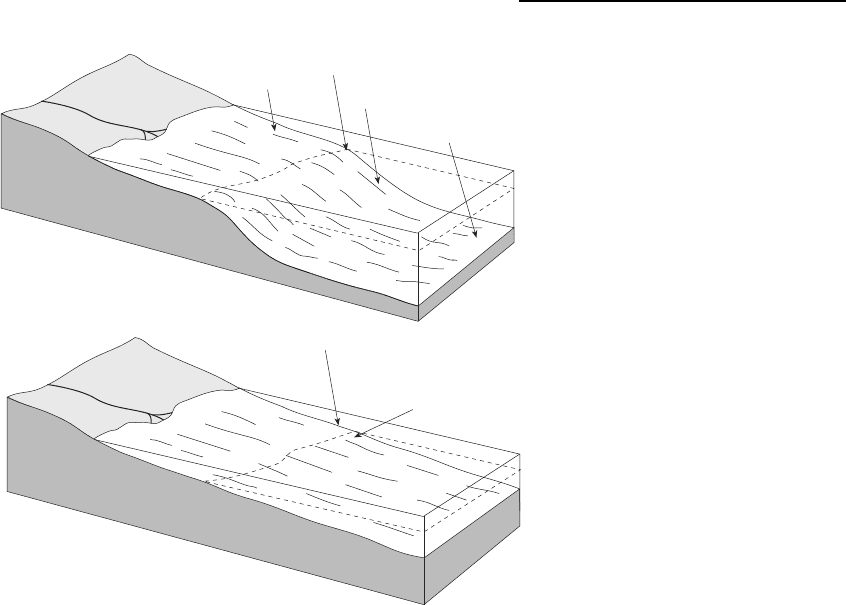
stratigraphy has resulted in the introduction of a large
number of new terms into sedimentary geology and
although at first this new terminology seems to be
quite daunting, it is generally quite logical and easy to
relate to the concepts. To illustrate and introduce the
application of sequence stratigraphic terminology,
and to show how facies distributions can relate to
changes in relative sea level, two types of continental
margin are considered, each with certain conditions
regarding rates of sea-level change and sediment sup-
ply. These two case studies are the ones most often
illustrated in texts on sequence stratigraphy (e.g. Coe
2003; Cateneaunu 2006), but variations on these
two are not only possible, but common, depending on
the rates of sea-level rise and fall, changes in sediment
supply, and the shape of the bathymetry of the shelf.
1 A continental margin with a distinct shelf break:
sediment supply is assumed to be constant, and the
sea level falls to below the edge of the shelf so that
there is erosion on the shelf during sea-level fall
(Fig. 23.5). Beyond the edge of the shelf lies a slope
and a deeper basin area that receives sediment during
certain stages of the sea-level cycle.
2 A continental shelf that is a sloping ramp with no
distinct change in slope: the sediment supply is again
considered to be constant and is relatively high such
that deposition occurs throughout the cycle (Fig. 23.5).
A deeper basin area may exist, but is not strongly influ-
enced by sea-level fluctuations on the ramp.
23.2.1 Shelf-break margin depositional
sequence (Fig. 23.6)
Highstand
The highstand is the period of high sea level during
the cycle and the beds deposited during this period are
called the highstand systems tract (HST). (A ‘sys-
tems tract’ is the term used in sequence stratigraphy
for strata deposited during a stage of a depositional
sequence.) The beds show either an aggradational or
a progradational pattern as the shoreline shifts sea-
wards across the shelf. Sediment is supplied by rivers
from the hinterland and most of the accumulation
occurs on the shelf with little sediment reaching the
deeper basin.
Shelf-break margin
Ramp margin
high sea level
high sea level
low sea level
low sea level
shelf
slope
deeper basin
shelf extends into
deeper water
shelf break
no shelf break
Fig. 23.5 Two main types of continental
margin are recognised, each resulting in
different stratigraphic patterns when
there are sea-level fluctuations: (a) shelf-
break margins have a shallow shelf area
bordered by a steeper slope down to the
deeper basin floor; (b) ramp margins do
not have a distinct change in slope at a
shelf edge.
358 Sequence Stratigraphy and Sea-level Changes
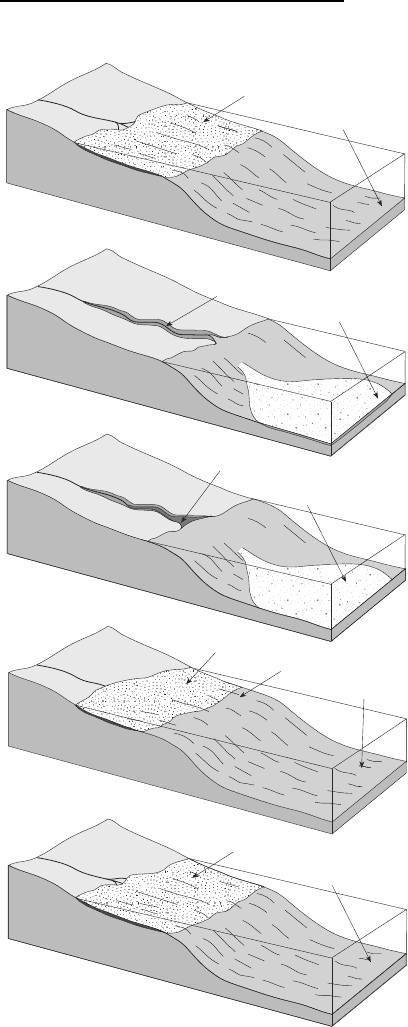
Sequence boundary
During sea-level fall erosion of the shelf occurs as rivers
erode into the sediment deposited during the previous
cycle: where erosion is localised the rivers cut incised
valleys. This erosion creates an unconformity, which
in this context is also called a sequence boundary
(SB). It marks the end of the previous depositional
sequence and the start of a new one: depositional
sequences are defined as the packages of beds that
lie between successive sequence boundaries. If the
sea level falls to the level of the shelf edge then both
the detritus from the hinterland being carried by the
rivers and the material eroded from the shelf are
carried beyond the edge of the shelf. This sediment
forms a succession of turbidites on the basin floor that
are deposited during the period of falling sea level,
forming a basin floor submarine fan. There is no
unconformity within the basin floor succession to
mark the sequence boundary, so the start of the
next sequence is marked by a correlative confor-
mity, a surface that is laterally equivalent to the
unconformity that forms the sequence boundary on
the shelf.
Lowstand
The interval of low sea level is called a lowstand and
the deposits of this period are called the lowstand
systems tract (LST). The relative sea level is rising
slowly but the rate of sediment supply is relatively
high. The rivers cease to erode on the shelf but the
shelf continues to be by-passed: sedimentation con-
tinues to occur on the basin-floor fan as turbidites
(also referred to as lowstand fan deposits). Sediments
also start to build up above the fan at the base of the
slope to form a lowstand wedge (not shown in
Fig. 23.6). The pattern of beds in these deposits is
initially progradational, becoming aggradational in
the lowstand wedge as the rate of sea level increases.
Transgressive surface
The point at which the rate of creation of accom-
modation due to relative sea-level rise exceeds the rate
of sediment supply to fill the space is called the trans-
gressive surface (TS). It marks the start of retrogra-
dational patterns within the sedimentary succession
as accommodation outpaces sediment supply. If sedi-
ment supply is relatively low the transgressive surface
may be erosional: surfaces of erosion formed during
pelagic deposits
in deep water
deposition on shelf
Highstand
Falling stage
Lowstand
Transgression
Highstand
submarine fan deposits
in deep water
fluvial incision and
erosion on shelf
reduced deposition
in deep water
estuarine deposition
pelagic deposits
in deep water
deposition near shore
pelagic deposits
in deep water
deposition on shelf
condensed facies on shelf
sequence boundary
highstand systems tract
lowstand system tract:
transgressive system tract
highstand systems tract
Fig. 23.6 Variations in sea level that follow the pattern in
Fig. 23.4 affecting a shelf-break margin result in a series of
systems tracts formed at different stages: the lowstand is
characterised by deep-basin turbidites if the sea level falls to
the shelf edge.
Depositional Sequences and Systems Tracts 359

transgression are called ravinement surfaces and
they form because high wave energy in the shallow
water that floods over the land surface can result in
erosion.
Transgressive systems tract
Deposits on the shelf formed during a period of relative
sea level rising faster than the rate of sediment sup-
ply are referred to as the transgressive systems
tract (TST). They show a retrogradational pattern
within the beds as the shoreline moves landwards.
Sediment is no longer supplied to the basin floor
because there is now sufficient accommodation on
the shelf. The relative sea-level rise results in the
formation of estuaries as the incised valleys are
flooded with seawater: estuarine sedimentation
(13.6) is characteristic of the transgressive systems
tract. The rise in base level further upstream creates
accommodation for the accumulation of fluvial depos-
its within the valleys.
Maximum flooding surface
As the rate of sea-level rise slows down the deposi-
tional system reaches the point where the accommo-
dation is balanced by sediment supply: when this
happens transgression ceases and the shoreline initi-
ally remains static and then starts to move seawards.
This point of furthest landward extent of the shoreline
is called the maximum flooding surface (MFS):it
should be noted that it does not represent the highest
sea level in the cycle, which occurs later in the high-
stand systems tract. As the point of the maximum
flooding surface is approached the outer part of the
shelf is starved of sediment because there is abundant
accommodation near the shoreline: very low sedi-
mentation rates on the shelf can be recognised by a
number of features including concentrations of authi-
genic glauconite and phosphorites (11.5.1, 3.4), con-
densed beds rich in fossils (11.3.2) and evidence of
sea-floor cementation from hardgrounds and firm-
grounds (11.7.4).
Highstand
A return to aggradational and progradational pat-
terns of shelf sedimentation marks the onset of the
highstand systems tract above the maximum flooding
surface. Continued relative sea-level rise creates
accommodation within the continental realm: fluvial
deposition is no longer confined within incised
valleys (cf. transgressive systems tract) resulting in
deposition in rivers and on overbank areas over wide
areas of the coastal plain.
23.2.2 Ramp margin depositional sequence
(Fig. 23.7)
Highstand
Highstand deposition on a ramp margin is essentially
the same as for the shelf-break example, with an
aggradational to progradational pattern of deposition
on the inner part of the margin.
Sequence boundary
The sequence boundary in the ramp succession is
placed on the surface on which there is the first
evidence of erosion caused by sea-level fall (Coe
2003). Erosion starts at the landward end, but further
seaward there will be continued sedimentation, with
the geometry of the strata changing from building
up to stepping down (i.e. from geometry IV to geome-
try VI on Fig. 23.3). This change in stratal geometry
may not always be easy to recognise in practice. It is
worth noting that in the original schemes for shelf-
break margins summarised in publications such as
Van Wagoner et al. (1990) the highstand was con-
sidered to continue into the initial stages of sea-level
fall and the sequence boundary placed at the point
when erosion was widespread across the shelf: if this
approach is applied to a ramp margin it would be
placed at some point within the succession deposited
during sea-level fall. Hunt & Tucker (1992) suggested
an alternative scheme in which the sequence bound-
ary is placed above all the strata deposited during the
period of falling sea level, but this creates the situation
where the sequence boundary lies within the package
of strata deposited in the basin in the shelf-break
setting.
Falling stage systems tract
Sediments deposited during the period from the onset
of the relative fall in sea level until the point where it
stops falling are considered to form the falling stage
systems tract (FSST) (Plint & Nummedal 2000). The
360 Sequence Stratigraphy and Sea-level Changes
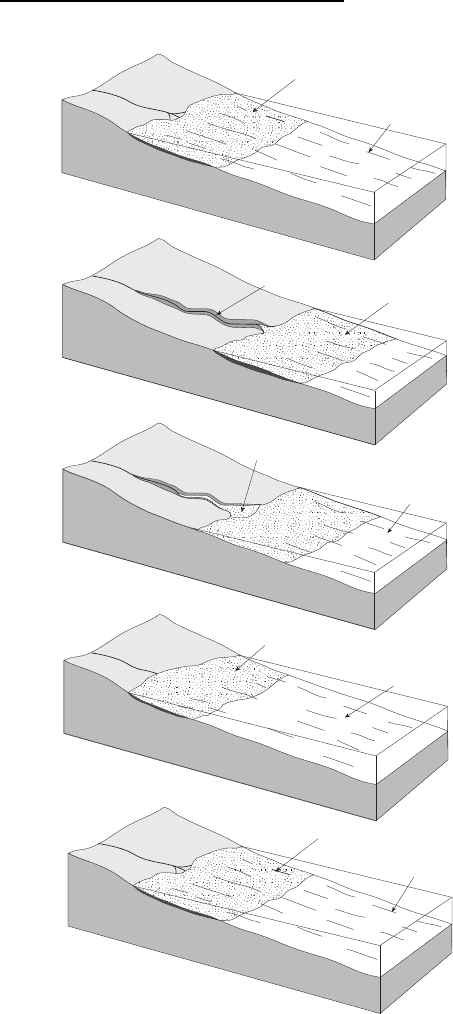
sediment is supplied by rivers from the hinterland and
also as a result of erosion of the landward part of the
ramp. Erosion by rivers may create incised valleys
between the landward part of the ramp and the shore-
line. The shoreline moves seawards and steps down as
the relative sea level falls and hence the geometry of
the strata is progradational and down-stepping. Note
that under the alternative scheme suggested by Hunt
deposition on inner ramp
Highstand
Falling stage
Lowstand
Transgression
fluvial incision and
erosion
reduced deposition
on outer ramp
estuarine deposition
deposition near shore
condensed facies
Highstand
mud deposition
on outer ramp
falling stage systems tract
highstand systems tract
lowstand system tract
deposition shifts down ramp
transgressive system tract
deposition on inner ramp
mud deposition
on outer ramp
highstand systems tract
Fig. 23.7 Variations in sea level that
follow the pattern in Fig. 23.4 affecting a
ramp margin result in a series of systems
tracts formed at different stages: during
lowstand the deposition is shifted down
the ramp.
Depositional Sequences and Systems Tracts 361
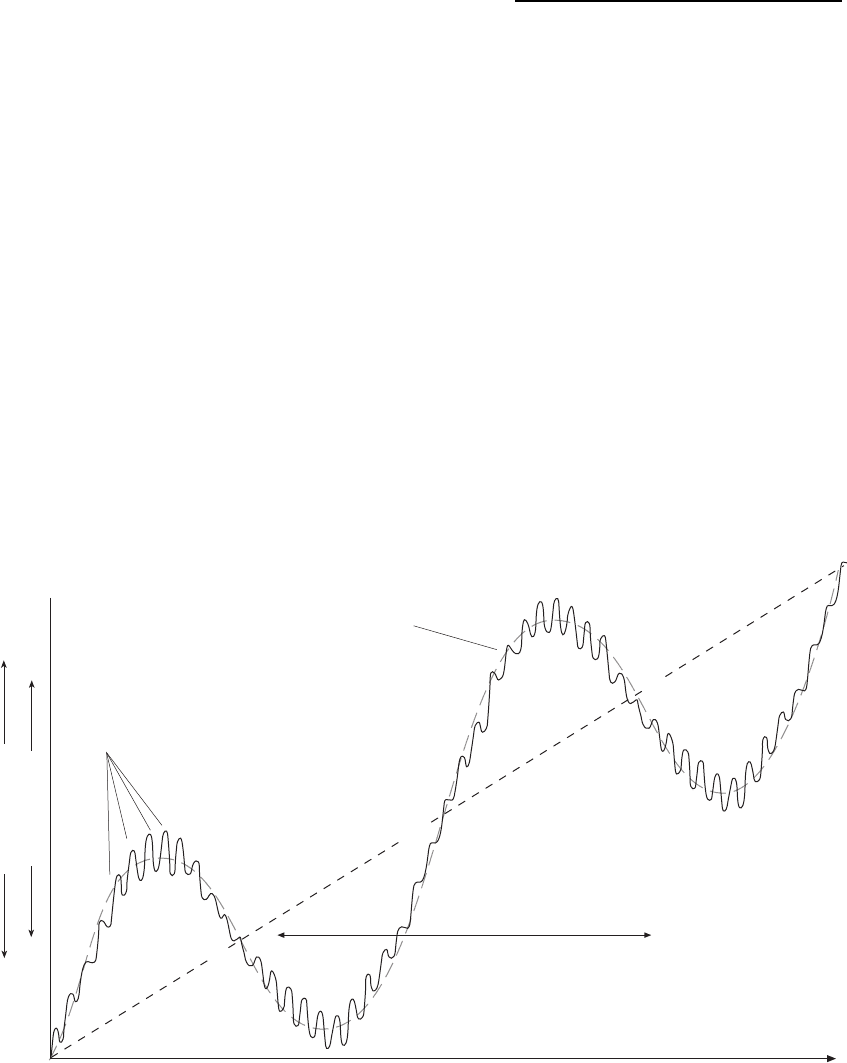
& Tucker (1992), these deposits would be considered
to be below the sequence boundary and they refer to
them as the forced regressive wedge systems tract
(FRWST).
Lowstand
The lowstand systems tract is deposited during the
early stages of sea-level rise. The inner part of the
ramp is no longer erosional and the water level starts
to rise in the incised valleys. The geometry of the
strata in the outer part of the ramp is progradational,
becoming aggradational as the rate of sea-level rise
increases and the shoreline stops moving seawards
and becomes stationary.
Transgressive surface, transgressive systems
tract, maximum flooding surface, highstand
The processes and patterns of sedimentation during
these stages of rising sea level are essentially the same
as for the shelf-break margin depositional sequence.
23.3 PARASEQUENCES: COMPONENTS
OF SYSTEMS TRACTS
23.3.1 Parasequences
Each of the systems tracts in Figs 23.6 and 23.7
is shown as consisting of several separate packa-
ges of strata. In detail each package is itself a cycle
of beds showing a progradational pattern and
these depositional cycles are known as parase-
quences in sequence stratigraphy terminology. They
form because the actual variation in sea level is
not the smooth sinusoidal curve shown in
Fig. 23.4: sea level does not rise or fall at steadily
varying rates as the smooth curve indicates, but
occurs in a series of shorter stages. A curve shape
generated by superimposing a short-term sinusoidal
pattern onto the longer term trend can account for
the variations in accommodation indicated by the
presence of parasequences (Fig. 23.8) During the
Depositional sequence
(Between sequence boundaries)
Highstand
systems tract
Lowstand
systems
tract
Parasequences
deposited during
short-term
sea level rises
F
a
l
l
i
n
g
s
tag
e
s
y
s
t
e
m
s
t
r
a
c
t
T
r
a
n
s
g
r
e
s
s
i
v
e
s
y
ste
m
s
t
r
a
c
t
S
e
q
u
e
n
c
e
bo
u
n
d
a
r
y
f
o
r
m
a
t
i
o
n
Background subsidence
Short-term sea level
fluctuation superimposed
upon long-term rise and fall
S
e
q
u
e
n
c
e
bo
u
n
d
a
r
y
f
o
r
m
a
t
i
o
n
Fall RiseRelative sea level
Time
decrease accommodation increase
Fig. 23.8 A higher frequency sea-level fluctuation curve superimposed on the curve in Fig. 23.4 produces a pattern of
short-term rises and falls in sea level within the general trends of transgression and regression. These short-term fluctuations
result in creation of small amounts of accommodation being created, even during the falling stage.
362 Sequence Stratigraphy and Sea-level Changes
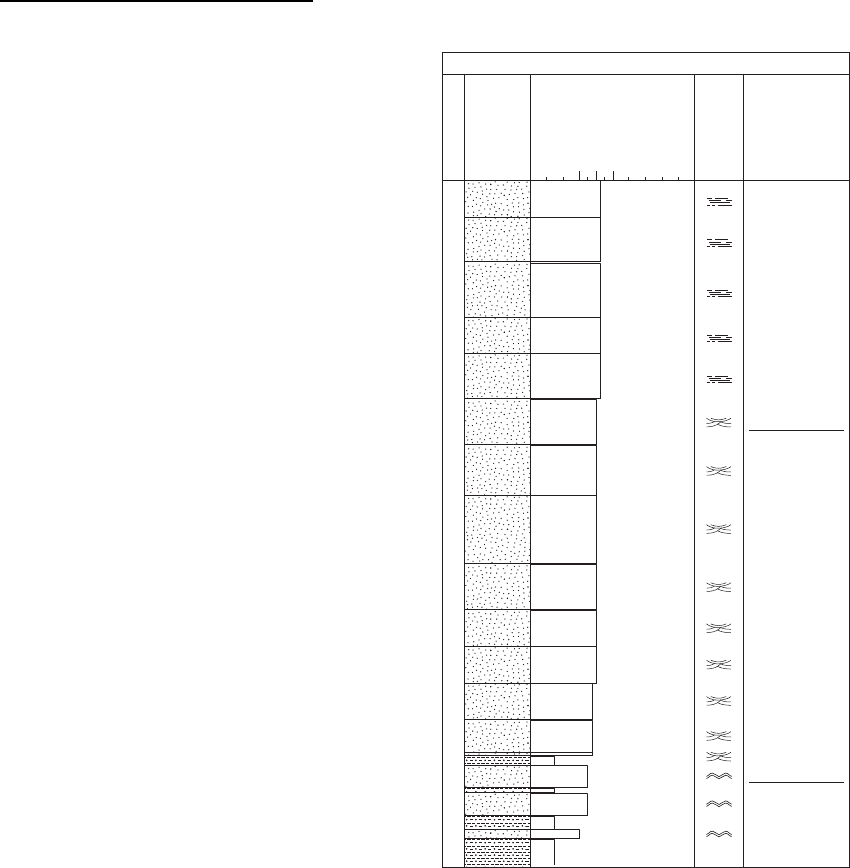
rising limb of the depositional sequence curve the
superimposed curve results in short periods of accel-
erated relative sea-level rise separated by periods
when sea level is rising more slowly or not at all.
Superimposition of curves on the falling limb creates
short periods when the relative sea-level rise is
enough to create some accommodation.
Parasequence boundaries
Parasequences are hence packages of beds deposited
as a consequence of the creation of a small amount of
accommodation that is then filled up by sediment.
Within a succession, the boundary of a parasequence
is marked by a facies shift from shallower to deeper
water deposition (e.g. from foreshore to offshore tran-
sition facies), which signals a sudden increase in rela-
tive sea level. This surface marking the parasequence
boundary is called a flooding surface (not to be
confused with a ‘maximum flooding surface’).
Parasequence thickness
The thickness of a parasequence measured between
flooding surfaces is determined by the relative sea-
level rise: it is usually in the range of metres to tens
of metres (Fig. 23.9). The accommodation created is
filled by sediment until the next flooding surface
occurs, and there are three different possibilities for
the succession of beds within the parasequence. If the
sea level is static between flooding events the thick-
ness of the beds representing each of the facies belts
will be equivalent to the depth ranges of those facies
belts: for example, if the foreshore covers the range
from 0 to 2 m depth, the foreshore deposits will be
2 m, and if the shoreface is from 2 to 15 m deep, the
shoreface facies will be 13 m thick, and so on. How-
ever, if the sea level is continuing to slowly rise during
the period of deposition of the parasequence, as could
happen in a transgressive systems tract, each of these
facies units will be thicker: this can be considered to
be an expanded succession within a parasequence.
On the other hand, falling sea level during parase-
quence formation would result in thinner units, per-
haps only 1 m of foreshore facies and 6 m of shoreface
deposits: such a foreshortened succession within a
parasequence would be characteristic of falling stage
systems tract. The facies present in a parasequence
and the thickness of beds will also be determined by
the position on the shelf where deposition is occur-
ring: in a more distal setting the parasequence will be
made up of finer grained facies (Fig. 23.10).
Parasequence sets
Although an individual parasequence shows an inter-
nal progradational bed pattern, they may be arran-
ged into parasequence sets that may overall show
progradational, aggradational or retrogradational
offshore transition
m - 10s m
shoreface
foreshore
MUD
clay
silt
vf
SAND
f
m
c
vc
GRAVEL
gran
pebb
cobb
boul
inner shelf parasequence
Scale
Lithology
Structures etc
Notes
Fig. 23.9 A schematic graphic sedimentary log of a para-
sequence in an inner shelf shallow-marine setting.
Parasequences: Components of Systems Tracts 363
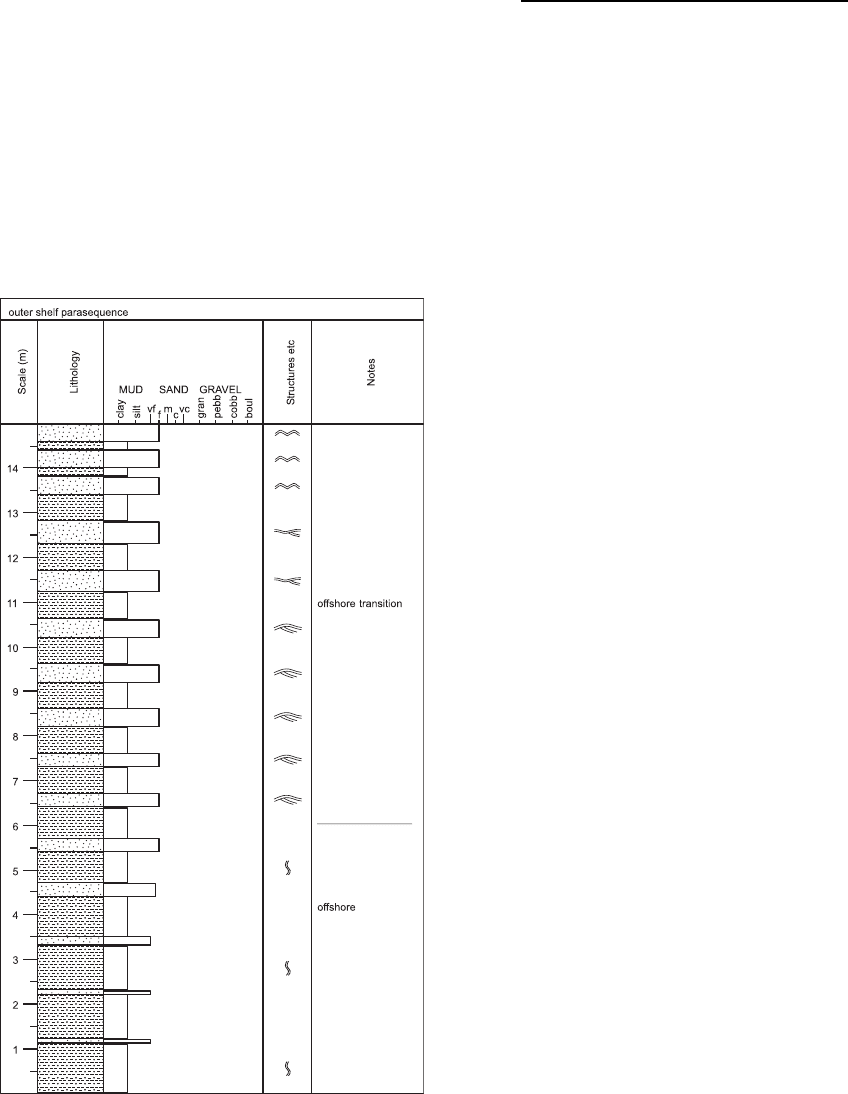
patterns (Fig. 23.10). In a progradational parasequence
set each successive parasequence going up through the
set shows shallower water facies, that is, an overall
shallowing-up trend. Retrogradational parasequence
sets are made up of parasequences that show a trend
of becoming deeper up through the succession, that is,
the top bed of the higher parasequence is a deeper water
facies than the beds that form the top of the parase-
quence below. In aggradational parasequence sets all
the individual parasequences show the same cycle of
facies with no overall trend of shallowing or deepening.
Parasequence sets and systems tracts
The trends within parasequence sets are indicative of
the systems tract that they make up (Fig. 23.11): a
highstand systems tract will have parasequence sets
with aggradational to progradational trends, a trans-
gressive systems tract is characterised by parase-
quence sets with a retrogradational trend, and a
lowstand by progradational to aggradational trends
within parasequence sets. A systems tract may be
made up of one or more parasequence sets, but all
sets in the same tract will show the same trends. In
falling stage systems tracts the parasequences are not
stacked vertically but are instead arranged laterally
(Fig. 23.12). The relationship between parasequences
within a fallings stage systems tract depends on the
rate of sea-level fall in relation to the rate of sediment
supply: with a high sedimentation rate or slow sea-
level fall the individual parasequences are stacked
against each other to form an attached falling
stage systems tract, whereas faster sea-level fall
and/or lower sediment supply results in a detached
falling stage systems tract (Fig. 23.12).
23.3.2 Sequences and parasequences:
scales and variations
Building up from parasequences, which are metres to
tens of metres thick, to parasequence sets and syst-
ems tracts, which are several tens of metres thick,
depositional sequences can be expected to be in the
order of a hundred metres or more in thickness. In
practice, depositional sequences vary from a few
metres to hundreds of metres thick depending on the
amount of accommodation that is created. The great-
est amount of accommodation occurs in places where
there is a large amount of tectonic subsidence that
occurs in certain types of sedimentary basin (Chapter
24). Accommodation tends to be much less in regions
that are tectonically stable and where the sea-level
variations are due to global eustatic fluctuations. The
mechanisms and magnitudes of relative sea-level
change are discussed in section 23.8.
The two conceptual models for the arrangement of
strata in depositional sequences present in section
23.2 are idealised and merely represent possible
Fig. 23.10 A schematic graphic sedimentary log of a
parasequence in an offshore shelf shallow-marine setting.
364 Sequence Stratigraphy and Sea-level Changes

scenarios. In addition to variations in the scales, there
is huge scope for variations in the character of the
deposits and the way that the strata are arranged
depending on the variables that control sequence
development. These variables are (a) the magnitude
of relative sea-level change, (b) the rate of relative sea-
level change, (c) the supply of sediment and (d) the
physiography of the margin. Different combinations of
these variables can generate any number of stratal
patterns, but there are several points to consider.
1 Rapid changes in relative sea level can lead to the
complete omission of systems tracts. For example, a
rapid sea-level rise can result in a succession of a
lowstand systems tract directly overlain by highstand
deposits, with no deposition during transgression.
Also, highstand deposits may be absent if relative
sea level falls abruptly after transgression and simi-
larly the lowstand systems tract may not be repre-
sented if there is a quick turnaround from fall to rise of
relative sea level.
2 The physiography of the margin and the magni-
tude of the relative sea-level changes determine the
proportion of the deposition that occurs in shallow
marine environments. Margins with a very wide shelf
with a shelf break below the lowest point of sea level
experience predominantly ramp-type geometries and
most of the sedimentation is accommodated on the
shelf, with little reaching the basin. Conversely, nar-
row shelves do not accommodate very much sediment
and it may be that only highstand deposits are pres-
ent, with the bulk of the deposition occurring on the
basin floor.
3 Sedimentation rates are important because if they
are low then accommodation will not be filled up and
progradation will be subdued, but at high sedimenta-
tion rates progradational geometries will tend to dom-
inate the succession.
23.4 CARBONATE SEQUENCE
STRATIGRAPHY
A fundamental difference between the behaviour of
carbonate depositional systems and terrigenous clas-
tic settings is the control on the supply of sediment. In
clastic depositional systems the sediment supply is
mainly detritus coming from a hinterland area sup-
plemented at times by the erosion and reworking of
material from the margin. In small clastic depositional
systems, such as alluvial-fan supplied fan-deltas at
active basin margins, there may be a close link
between relief, sediment supply and relative sea
Fig. 23.11 The stacking patterns of
parasequences to form parasequence sets
are characteristic of different systems
tracts.
Progradational parasequence set
sediment input > accommodation
Retrogradational parasequence set
sediment input < accommodation
Aggradational parasequence set
coastal plain
foreshore
shoreface
offshore transition
offshore
sediment input = accommodation
parasequence
Carbonate Sequence Stratigraphy 365
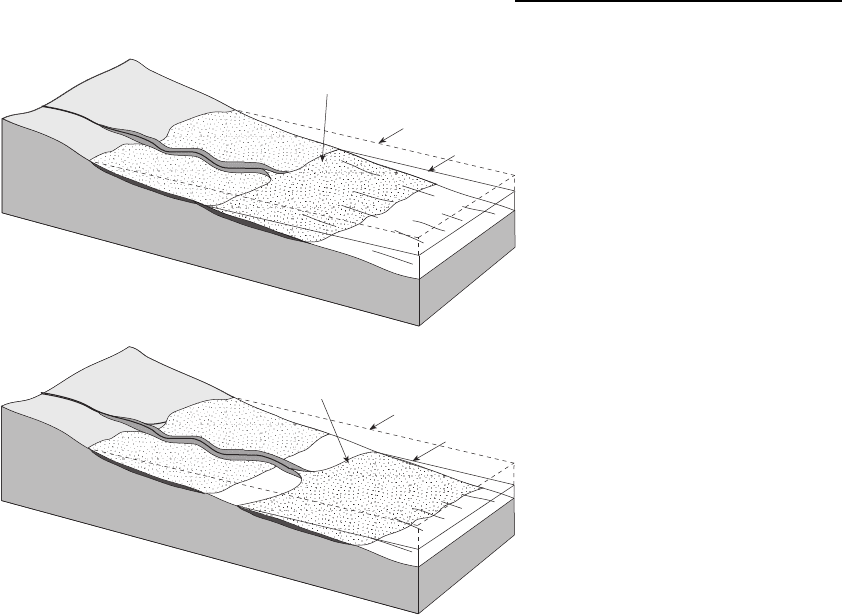
level. However, although there are some links
between climate, sea level and rates of erosion, the
sediment supply through larger scale, continent-wide
fluvial systems, however, is largely independent of
relative sea-level fluctuations. In contrast, supply of
material in carbonate settings is governed mainly by
the factors that control biogenic productivity
(15.1.1), such as water temperature, salinity, nutri-
ent supply, suspended sediment content, water depth
and the area of the shelf that is available for produc-
tion (Tucker & Wright 1990). Fluctuations in relative
sea level determine both the water depth and the shelf
area and so there is a direct link between relative sea
level and sediment supply in carbonate depositional
systems. There is a lot of production of sediment if
there is a large area of shallow water, but if this area
is reduced, the amount of sediment supply also drops.
The pattern of strata in a carbonate rimmed shelf
during a cycle of relative sea-level rise and fall is
shown in Fig. 23.13. The character of the systems
tracts will depend on the relative rates of sea-level rise
and carbonate production. If the sea-level rise is rapid
the shelf floods and there is a thin retrogradational
package of beds making up the transgressive systems
tract: the outer shelf area may be starved of sediment
allowing the development of condensed beds and
hardgrounds that will mark the maximum flooding
surface. The following highstand systems tract will be
aggradational to progradational. Under conditions of
slow relative sea-level rise the carbonate production
keeps pace and the pattern of beds is aggradational to
progradational: the transgressive systems tract will
pass without a maximum flooding surface into a pro-
grading highstand systems tract. A fall in sea level
that results in the exposure of the shelf or ramp
carbonate sediment can normally be recognised by
the presence of solution, karstification, soil develop-
ment and/or subaerial evaporite formation. Smaller
falls in sea level can result in a restriction of circula-
tion to the shelf lagoon, leading to hypersaline condi-
tions in arid regions and reduced salinity in humid
climates. Either way, the change in water chemistry
will be reflected in the organisms in the lagoon as
biodiversity is reduced under these conditions. Fall of
the sea level below the shelf edge dramatically reduces
the area of the carbonate factory to a small patch on
Falling stage
high sea level
attached falling stage systems tract
Falling stage
detached falling stage systems tract
low sea level
deposition shifts down ramp to
form continuous unit
deposition shifts down ramp with shoreface
deposits of low sea level detached from
those of high sea level
high sea level
low sea level
Fig. 23.12 A falling-stage systems tract
(FSST) on a ramp margin can show dif-
ferent patterns of deposition: if the sea
level falls relatively slowly with respect to
sediment supply deposition forms a con-
tinuous succession across the ramp as an
attached FSST; relatively fast sea-level
fall results in a detached FSST.
366 Sequence Stratigraphy and Sea-level Changes
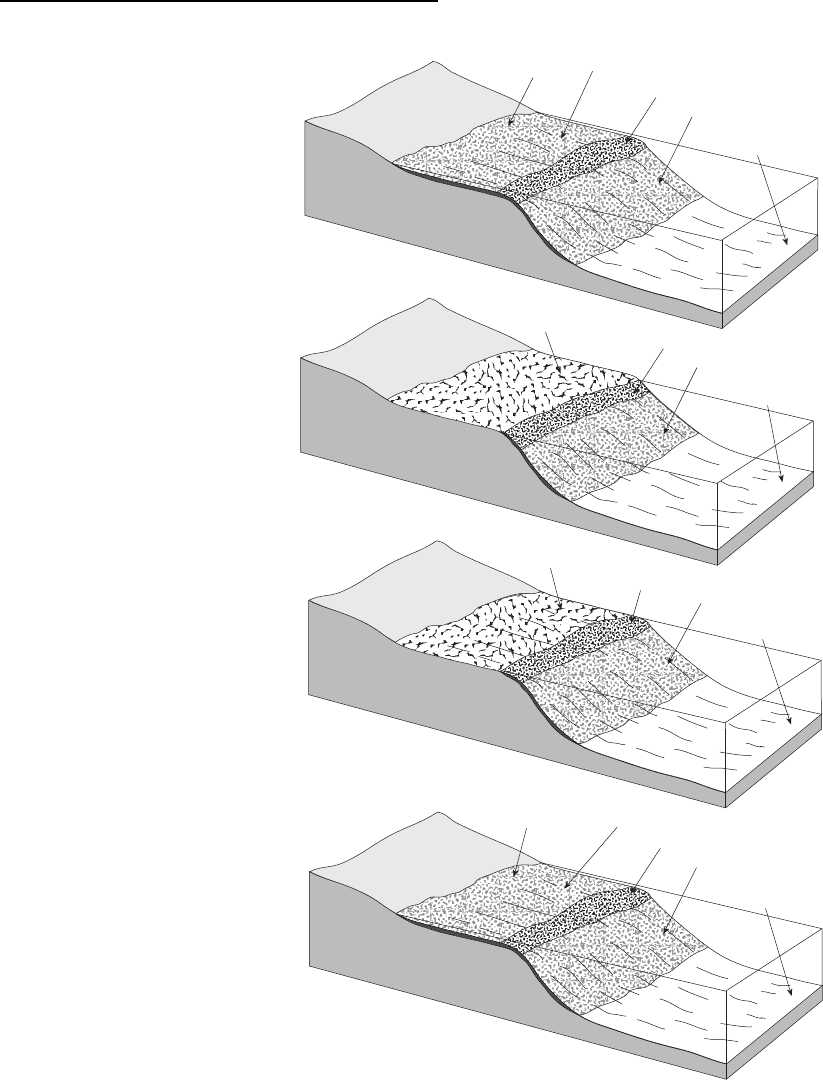
Fig. 23.13 The responses of a carbo-
nate rimmed shelf to changes in sea
level. An important difference with
clastic systems tracts is that the carbo-
nate productivity varies because most
carbonate material is biogenic and
forms in shallow water. During high-
stand and transgressive systems tracts
wide areas of shallow water allow more
sediment to be formed, whereas at fall-
ing stage and lowstand production of
carbonate sediment is much lower.
pelagic deposits
in deep water
shallow carbonate deposition
Highstand
Falling stage
Lowstand
Transgression and
highstand
sequence boundary
highstand systems tract
lowstand system tract
transgressive systems tract
and highstand systems tract
reef and shoal deposits on shelf edge
slope deposits
sabkha/mudflats
pelagic deposits
in deep water
exposed shelf -
karst formation
narrow platform on shelf edge
slope deposits
pelagic deposits
in deep water
reef, shoal deposits on narrow platform
slope deposits
exposed shelf -
karst formation
pelagic deposits
in deep water
shallow carbonate deposition
reef, shoal deposits on shelf edge
slope deposits
sabkha/mudflats
Carbonate Sequence Stratigraphy 367
